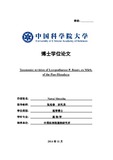Please use this identifier to cite or link to this item:
http://archive.nnl.gov.np:8080/handle/123456789/287| Title: | Taxonomic revision of Lycopodiaceae P. Beauv. ex Mirb. of the Pan-Himalaya |
| Authors: | Shrestha, Nawal |
| Keywords: | Lycopodiaceae Morphology Multivariate analysis Species distribution modeling Ttaxonomy |
| Issue Date: | 20-Feb-2018 |
| Abstract: | Lycopodiaceae are ancient, homosporic vascular plants with an estimated 400 species in the world. The taxonomic status of the genera and species belonging to this family has been a long standing dispute among taxonomists chiefly due to its simple morphology and alternative interpretation of morphological characters. With regard to taxonomy of Himalayan Lycopodiaceae, there have been very few studies carried out until now. The studies so far in the Himalayan region have focused more on floristic surveys and enumerations. Although, the species diversity of Himalayan species of Lycopodiaceae was assessed on a fragmentary basis by many taxonomists, none of them covered all of the Himalayas and therefore, the studies are inadequate. Keeping in view the insufficient knowledge on Himalayan Lycopodiaceae, detailed taxonomic revision has been undertaken in the present work. The study is an attempt to assess species diversity of Lycopodiaceae in the Pan-Himalayan region using evidences from morphology, anatomy and ecology. Over 3000 specimens as well as photographs of the specimens deposited at ASSAM, BM, CAL, CDBI, E, H, HUST, IBSC, KATH, K, KUN, LINN, MO, NY, P, PE, PYU, S, SZ, TI, TUCH and UPS were examined. Morphological characters were studied with the help of stereo microscope and measurements were made using NIS-Elements D 3.10. Anatomical studies were limited to stem anatomy and leaf epidermis. Multivariate analyses performed in IBM SPSS Statistics v. 21 and PAST v. 7.5, were used to assess the significance of studied morphological characters and delineate species boundary in Huperzia serrata complex. MAXENT v. 3.3.3k and R v. 3.0.2 were used to create distribution models of selected species in order to identify potential areas of their distribution and infer climatic boundaries. Distribution maps were produced using DIVA GIS 7.5 based on specimen label geographic data as well as secondary data. The results indicated that plant height, width of branchlets, density of leaves, leaf shape and size, phyllotaxy, leaf margin are the most important character in delimiting taxa in this family. Some mircromorphological characters (eg. leaf epidermal cells, stomata, etc.) are too useful in segregating problematic taxa. The size of sporangium, its outline and depression at the point of attachment varies between species. Sporangia are either reniform or circular in outline with varying degree of grooves. Species of Lycopodium have comparatively thinner sporangial walls than Huperzia. Gemmae are a common feature of terrerstrial species of Huperzia and almost absent in epiphytic forms. Although, sporangial and gemmae characters are not unique to individual species, they are useful in segregating groups. There is great variation in the organization of stele in different species and are useful in segregating taxa. Diversity is highest among the terrestrial as well as epiphytic species of Huperzia. Lycopodiaceae species richness in the Himalaya has a pronounced peak at 2000 m and decreases in both directions which is primarily caused by climatic factors rather than hard boundaries. The present study has reported 38 species from the Himalaya. Due to unavailability of material and lack of sufficient studies, the taxonomic identity of two species could not be verified and hence they are regarded as doubtful species. Huperzia is represented by 28 species, Lycopodium by 9 species and Lycopodiella by 1 species in the Himalaya. Fifteen species (14 Huperzia + 1 Lycopodium) are endemic to China. H. subulifolia (Wall. ex Hook.& Grev.) Trevis. is possibly a new record for China. It was previously regarded as a synonym of H. pulcherrima. However, on the basis of morphology and anatomy, these two taxa can be clearly separated. Five sections have been proposed for Huperzia with two new combinations: H. sect. Huperzioides (H.S. Kung & Li Bing Zhang) N. Shrestha & X.C. Zhang and H. sect. Phlegmariurus (Herter) N. Shrestha & X.C. Zhang. Five species viz: Huperzia leishanensis X.Y. Wang, Huperzia lajouensis Ching, H. dixitiana P. Mondal & R.K. Ghosh, Huperzia austrosinica Ching and Lycopodium verticale Li Bing Zhang have been synonymised under Huperzia kunmingensis Ching, Huperzia tibetica (Ching) Ching, Huperzia appressa (Desv.) Á. Löve & D. Löve, Huperzia petiolata (C.B. Clarke) R.D. Dixit and Lycopodium obscurum L. respectively. Based on our analysis of morphological with climatic data and ecological niche modeling, four species: H. crispata, H. nanlingensis, the H. serrata and H. javanica have been recognized in Huperzia serrata complex. The results, however, do not support the recognition of other infraspecific taxa previously recognized under H. serrata. The present work is the first comprehensive account of the Himalayan species of Lycopodiaceae and the results, although approximate, have provided a clear insight of the species diversity in the Himalayan region. It has also paved the way for future morphological and/or molecular studies for this family. |
| Description: | Dissertation submitted to University of Chinese Academy of Sciences in partial fulfillment of the requirement for the degree of Doctor of Natural Science, Institute of Botany, the Chinese Academy of Sciences, 2014. |
| URI: | http://103.69.125.248:8080/xmlui/handle/123456789/287 |
| Appears in Collections: | 500 Natural sciences and mathematics |
Files in This Item:
| File | Description | Size | Format | |
|---|---|---|---|---|
| Nawal_Shrestha_PhD Thesis_Final.pdf | 11.1 MB | Adobe PDF |  View/Open |
Items in DSpace are protected by copyright, with all rights reserved, unless otherwise indicated.